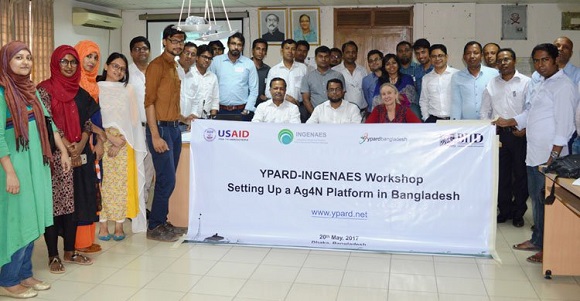The global agriculture coalition Farming First is launching a five-week online campaign calling attention to the
-
About
- Our Work
- Get Involved
- Stay Updated
Highlights
 Does the idea of buying your own farm sound like a fairytale? Here, five ways to realize your dream of working in the dirt, no down payment required.
Does the idea of buying your own farm sound like a fairytale? Here, five ways to realize your dream of working in the dirt, no down payment required.The National Young Farmers Coalition surveyed 1,300 of its members to identify the most significant barriers to a career in agriculture. Among the most common answers? Lack of affordable land. Real estate prices—at least near lucrative markets for sustainably farmed produce and meat—continue to rise, while farming remains a high-risk, low-pay pursuit. So newbies have started to get creative. These five smart solutions allow you to turn the agrarian fantasy into real life—without depleting your bank account.
 A new European centre of excellence for the development of advanced technologies in sustainable agriculture and food security will open in Serbia with the aim to boost economic growth in the region.
A new European centre of excellence for the development of advanced technologies in sustainable agriculture and food security will open in Serbia with the aim to boost economic growth in the region.Global food demand is set to continue increasing in coming years, placing additional pressure on limited natural resources. Innovative agricultural solutions are needed to produce more food from fewer resources and inputs.

Strengthening resilience and food security for agricultural communities is necessary for transforming agriculture, wellness and development of people, especially the youth, in Africa.
Salient to me from the Ministerial Conference on Global Open Data for Agriculture and Nutrition and the 4th Agritec Africa International Exhibition in Kenya last week (14-16 June) was that droughts, floods, and rising temperatures are already cutting crop yields, threatening fish stocks and meat supply, and pushing people deeper into poverty.
Organised by Global Open Data and Nutrition, the meeting assembled critical players in the African agriculture sector such as ministers, farmers, private agribusiness firms, financial institutions, civil society, scientists and international development partners to discuss and develop concrete plans for achieving measures to reduce food crises in Africa.
In response to ongoing efforts to redefine the Common Agricultural Policy (CAP) CEJA has today released its vision for the future CAP in the document Young Farmers are Key in the Future CAP, which they presented to Commissioner Hogan’s Head of Cabinet Peter Power during a meeting in Brussels.
 By 2050, the world’s population will need twice as much food as it consumes now. About 40 % of the Earth’s land is already used for agriculture and the need to produce more food threatens any fertile land that remains. More intensive farming — as it is often practised today — is likely to lead to more deforestation, soil erosion, water pollution and biodiversity loss.
By 2050, the world’s population will need twice as much food as it consumes now. About 40 % of the Earth’s land is already used for agriculture and the need to produce more food threatens any fertile land that remains. More intensive farming — as it is often practised today — is likely to lead to more deforestation, soil erosion, water pollution and biodiversity loss.Over the last 100 years, farmers have intensified farming by using heavier machinery and cheap agro-chemicals— pesticides and artificial fertilisers. “Unfortunately,” LIBERATION project coordinator David Kleijn points out, “too much fertiliser, pesticides and heavy machinery can adversely impact the environment.”
The European Parliament has called for urgent action to combat the concentration of agricultural land and to provide access to land for small and medium farmers. On April 27, it adopted a resolution and approved with a large majority an own-initiative report that recognizes the problem of land concentration in the EU and demands adequate responses. Land grabbing, the large-scale purchase of land for financial investment and industrial agricultural production, is no longer just a problem for developing countries. The report shows that not only in the former communist countries, but all over Europe, corporations are buying up large areas of land, often through legal loopholes. This has further increased the level of farmland concentration and tenure across the EU. Currently, only 3% of farms control more than 52% of arable land in Europe, whereas 76.2% of farms control only 11.2% of the agricultural land. The resolution underscores that this places inequality of land use in the EU – with a Gini coefficient of 0,82 – on a par with that of countries such as Brazil, Columbia and the Philippines, which are infamous for their notoriously unfair land distribution.

Food and nutritional security is now become the global challenge. Within lots of initiatives and programs to achieve the sustainable development goals of UNs, it is thought to be the major obstacle. Standing at world`s eighth largest population, Bangladesh has also puts priority action on food and nutritional security.
 Mapping the Earth’s surface from above is no longer the exclusive privilege of map producers or the military. Meteorologists can also make good use of satellite images, and channel the data into agricultural planning and production.
Mapping the Earth’s surface from above is no longer the exclusive privilege of map producers or the military. Meteorologists can also make good use of satellite images, and channel the data into agricultural planning and production.At a week-long FAO training session starting today in Budapest, international experts on meteorology, remote sensing and climate issues will forge ties and exchange knowledge with representatives of Central and Eastern European countries. The expected result is better weather and climate information – especially drought monitoring and management – for the benefit of food producers and water managers.
Page 15 of 116
Get in touch
Email: [email protected]
YPARD Global Coordination UnitHosted by AGRIDEA and the Czech University of Life Sciences Prague
Lausanne, Switzerland and Prague, Czech Republic - Our Work

